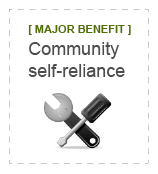Remove barriers to and encourage installation of renewable energy generation capacity.
Melissa Birch, Co-Director, Clean Energy Resource Teams: 218/866-2338, mbirch@umn.edu, www.cleanenergyresourceteams.org


- 56% of the energy generated in Minnesota is wasted (see Lawrence Livermore infographic for MN), mostly as unused heat from electricity generation and vehicles. This waste provides huge opportunities to cut waste and costs through reuse of waste heat (e.g., at power plants), increased efficiency in the use of energy (e.g., via electric vehicles), and in the generation of renewable electricity and much more efficiently from Minnesota's wind and solar resources, which, in the case of solar, should be looked at and calculated as proven solar reserves the way economists do for proven oil and gas reserves.
- CERTS (Minnesota's Clean Energy Resource Teams) produce case studies that emphasize community benefits of increasing local renewably generated energy, which include financial and environmental benefits, along with benefits to public health and to a community's resilience to energy price and supply shocks.
- Public health and financial benefits accrue to the state when energy is generated by renewable sources, as opposed to generation from non-renewable sources such as coal, oil and natural gas. The financial, agricultural, energy, and key ecosystem benefits generated by pollinator-friendly plantings under solar panels installations have been modeled and are impressive.
- See also several free EPA benefit tools (including COBRA, AVERT) that calculate the multiple financial, emissions, health benefits for cities that adopt energy efficiency and renewable energy policies and practices.
- Installation of "behind the meter" renewable electricity generation equipment can shave off peak electricity demand and allow the monthly utility demand charge - which can be a substantial portion of a city's total monthly electricity bill - to be decreased. Jump-Start - Battery Storage (Clean Energy Group: 2018) presents 10 benefits of battery storage across all elements of the current and emerging renewable energy system, and recommends over 50 actions to accelerate battery storage deployment.
- Minnesota's Next Generation Act of 2007 sets the following statewide goals:
- cutting greenhouse gas emissions to 15% below 2005 levels by 2015, 30% by 2025, and 80% by 2050;
- cutting energy use post-2012 equal to 1.5% of annual retail sales of electricity and natural gas;
- cutting per capita fossil fuel use by 15% by 2015, through increased reliance on energy efficiency and renewable energy;
- deriving 25% of MN's electricity from renewable energy resources by 2025.
- 2010 legislation creating a Property Assessed Clean Energy (PACE) program enables local governments to sign on-to/create voluntary programs that will allow property owners to finance solar, other renewable energy, energy efficiency, and electric vehicle plug-in improvements to their homes or businesses through voluntary property assessments.
- Minnesota laws support distributed generation (DG), for which renewables are ideal. Minn. Stat. 216B.1611, 2426 require utilities to plan for and integrate DG resources into the utility system. Minn. Stat. 216B.2411 allows 10% of Conservation Improvement Program spending on DG.
- The 2013 Minnesota Legislature enabled the creation of Community Solar Gardens: centrally-located solar photovoltaic (PV) systems that provide electricity to participating subscribers. The Solar Sanctuaries Act of 2016 establishes voluntary native vegetation and habitat management practices in the footprint of solar installations, such as pollinator-friendly habitat.
Optional Best Practice for Step 3 Recognition
Category A and B cities: implement this best practice by completing any two actions.
Category C cities: implement this best practice by completing any one action.
Minnesota has abundant wind, solar and bioenergy resources, but no indigenous fossil fuel reserves. While Minnesota has made great strides in renewable electricity generation 73% of all energy consumed in the state still comes from fossil fuels used for electricity generation, heating, industrial process, and transportation (MN Dept. of Commerce, 2020). While much of the state’s renewable energy infrastructure is thanks to energy utility providers, adding renewable energy generation capacity that is owned by local government, residents, businesses and educational institutions:
- Develops underutilized local energy resources, keeping dollars available for re-spending in the community.
- Increases a community's resilience to energy supply and price shocks (and cuts peak energy use and resulting electric demand charges).
- Cuts greenhouse gas emissions in support of the state's Next Generation Energy goals.
- Decreases health care costs to individuals and the state due to displacing coal air emissions with clean energy.
Local renewable energy sources include power from wind, the sun, and biomass feedstocks (wood, ag waste, waste water, municipal solid waste). Short of generating renewable energy locally, a city can include purchase of renewably generated power in its environmentally preferable purchasing policies.
Metric #14: Renewable Energy
